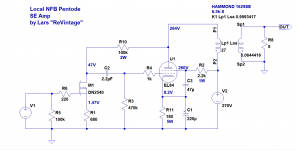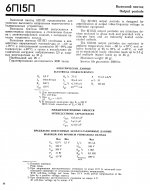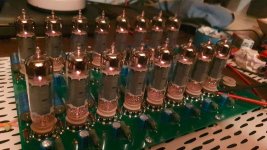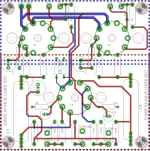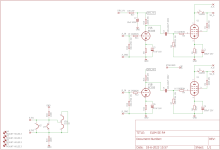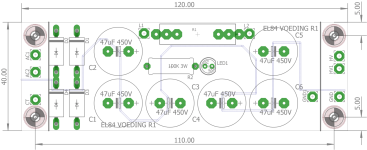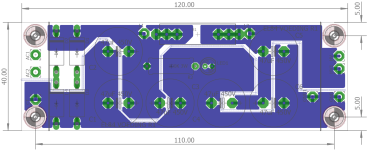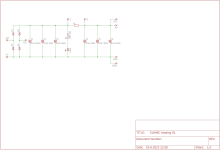Two other ideas for a SE EL84 design...
Tubelab SSE (Simple Single-Ended)
The PCB is for octal output tubes but the circuit can be modified to use EL84/6BQ5.
Tubelab SSE | Tubelab
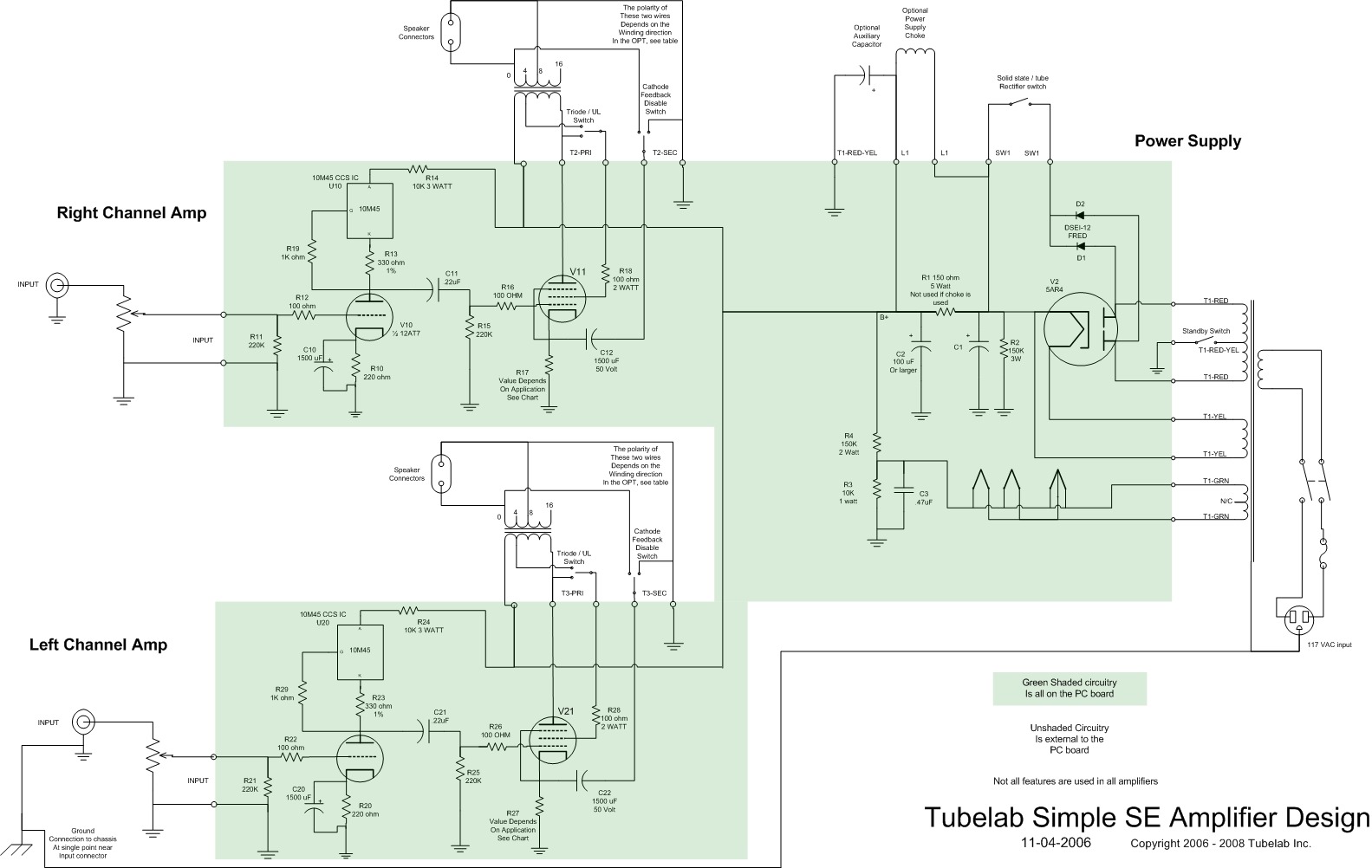
Attached is a design after suggestions by members Michael J Koster and ReVintage, from the 'Schadeode' threads back a while ago. It's a hybrid with a depletion mode MOSFET as the input voltage amp/driver stage. Plate-grid (local) negative feedback around the EL84. It should make about 5W out.
Tubelab SSE (Simple Single-Ended)
The PCB is for octal output tubes but the circuit can be modified to use EL84/6BQ5.
Tubelab SSE | Tubelab

Attached is a design after suggestions by members Michael J Koster and ReVintage, from the 'Schadeode' threads back a while ago. It's a hybrid with a depletion mode MOSFET as the input voltage amp/driver stage. Plate-grid (local) negative feedback around the EL84. It should make about 5W out.
Attachments
Btw, with LTSpice if you do have the output tube model, you should be able to simulate any CFB schematic.
For the 70th Birthday of my father, I put together a full transformer and choke kit for a PC86 + PL83 amp and I had three days to do it. It's a capacitor coupled pentode SE CFB amp. No time to test, so I relied on my previous experience with the PL82, the simple formulas from Turner Audio and an LTSpice sim. It worked flawlessly, yesterday he managed to put together the amp and it's singing now.
Sounds interesting . . . could you post a schematic?
I have not built one, but friends tell me the best sounding SE EL84 amp is a 6P15S amp.
Sounds like he may have been affected by Decware propaganda. also called SV63, a slightly less potent variation on the EL84. I prefer 6∏14C.
dave
Attachments
Wavebourn really likes the 6P15P. It's similar to 6P14P/EL84 but has a higher gm g2, which means it can't take as high g2 voltage. EL84 would be the better choice for UL use.
It's really not a better/worse thing. They're two (slightly) different tubes.
The higher gm g2 of the 6P15P might make it a better choice for pentode use with a regulated g2 supply at something like 200V. Perhaps...
It's really not a better/worse thing. They're two (slightly) different tubes.
The higher gm g2 of the 6P15P might make it a better choice for pentode use with a regulated g2 supply at something like 200V. Perhaps...
This is the concept. I deliberately left components valueless due to the flexibility of operating modes.
Another cool feature, it needs little negative voltage bias and you can get away with a 100-120R small cathode resistor instead of using fixed bias. The cathode feedback coil Rdc also contributes to some cathode bias.
At some point near peak power, g2 starts drawing peaks of current. If the g2 supply voltage impedance is somewhat high, the inability to supply current to g2 will be the bottleneck to squeeze the last watts.
At optimal pentode loadline, calculated simply by Zopt=Ua/Ia * 0.9, LTspice shows a power output efficiency with the transformers Rdc included at 46% at clipping onset. Which translates to 4.5W at 9.45W plate dissipation.
At my first experiment with PL82, I had the loadline calculated wrong due to failure to include the cathode winding impedance into the loadline impedance. With trial and error adjustments, I reached an efficiency of 43% there.

Output is 9.4V peak (6.66Vrms) over 10R load resistor. Zeners adjusted at 230Vdc across g2. Tube operating mode - Ua = 270V, Ia = 35mA

Another cool feature, it needs little negative voltage bias and you can get away with a 100-120R small cathode resistor instead of using fixed bias. The cathode feedback coil Rdc also contributes to some cathode bias.
At some point near peak power, g2 starts drawing peaks of current. If the g2 supply voltage impedance is somewhat high, the inability to supply current to g2 will be the bottleneck to squeeze the last watts.
At optimal pentode loadline, calculated simply by Zopt=Ua/Ia * 0.9, LTspice shows a power output efficiency with the transformers Rdc included at 46% at clipping onset. Which translates to 4.5W at 9.45W plate dissipation.
At my first experiment with PL82, I had the loadline calculated wrong due to failure to include the cathode winding impedance into the loadline impedance. With trial and error adjustments, I reached an efficiency of 43% there.

Output is 9.4V peak (6.66Vrms) over 10R load resistor. Zeners adjusted at 230Vdc across g2. Tube operating mode - Ua = 270V, Ia = 35mA

Last edited:
oemcar,
Tubes amplifiers with a 400V power supply are one thing.
Yes, failures can happen.
Things blow out, burn, etc.
Solid State amplifiers are not all immune to failures either.
An early Hitachi MOSFET amplifier design temporarily had the output terminals shorted.
One of the MOSFETs got hot so quickly, that a hole was burned in the top of the TO3 package.
50V 30,000uF caps can supply all kinds of transient current.
Experimenting with tube amplifiers, and with SS amplifiers . . .
Your Mileage May Vary
Tubes amplifiers with a 400V power supply are one thing.
Yes, failures can happen.
Things blow out, burn, etc.
Solid State amplifiers are not all immune to failures either.
An early Hitachi MOSFET amplifier design temporarily had the output terminals shorted.
One of the MOSFETs got hot so quickly, that a hole was burned in the top of the TO3 package.
50V 30,000uF caps can supply all kinds of transient current.
Experimenting with tube amplifiers, and with SS amplifiers . . .
Your Mileage May Vary
….also called SV63, a slightly less potent variation on the EL84. I prefer 6∏14C.
dave
Dave,
I shall appreciate hearing more about your experience with using the 6P15P tube upon which you base your preference for 6∏14C. I mentioned the 6P15P because it seemed worth the consideration of the OP, who stated (post #1) that he will use pentode connection and a regulated screen supply.
The SV83 tube data you reposted was authored by Svetlana USA. This version of data is different from the attached “real” Russian tube data for 6P15P, which gives maxima for both Ua and Ug2 as 330V (screen dissipation is 1.5 W max). EL84 data sheets typically give 300V, 300V max and 2 watts respectively.
It would be good to find out what the real capabilities of the real 6P15P tubes are. But that may be a topic for another thread.
Attachments
oemcar,
Tubes amplifiers with a 400V power supply are one thing.
Yes, failures can happen.
Things blow out, burn, etc.
Solid State amplifiers are not all immune to failures either.
An early Hitachi MOSFET amplifier design temporarily had the output terminals shorted.
One of the MOSFETs got hot so quickly, that a hole was burned in the top of the TO3 package.
50V 30,000uF caps can supply all kinds of transient current.
Experimenting with tube amplifiers, and with SS amplifiers . . .
Your Mileage May Vary
From a lethality aspect,,,
I prefer to increase my mileage by not experimenting w/ 400v-
Still subscribing ;<)
Jim
I ordered recently a little stereo amp from China with 1x6n1p and 2xel84 SE from a manufacturer who claims having many years of existence and optimising its amps. Various versions available, as a kit or assembled, with or without tubes. I ordered assembled, no tubes.
Simple amp: 1 input source, on-off switch, volume control, 4+8 ohm speaker posts.
Looked quite serious on the pictures: valve rectification, choke ht filtering, ventilation holes around the sockets, simple yet clean internal point to point wiring. Only the output trannies looked a bit small to pass real low frequencies, i thought, even if only for a 2x4-5 watter.
Cost: around 160 euros plus another 100 for shipping and possibly taxes. A
Installed my better European equivalent tubes.
Connected straight to a good cd player.
This thing is unbelievably good. And I mean real good. The usual qualities of the el84 are well perceptible (liveliness and dynamics, resolution, timbre etc). Driving a large speaker system at 100+ dB with 2x15” woofers per channel. Absolutely dead silent operation even on my large mid/high horns. Nothing you’d expect is missing. The little trannies are pretty magical to pass soooo much of the frequency band from top to bottom
This has been an eye opener for me as regards how much is possible from that much simplicity. And another confirmation that the el84 is a great little tube. Will organise soon a little competition with my friends’ very big tetrode and triode amps. Haha…
Simple amp: 1 input source, on-off switch, volume control, 4+8 ohm speaker posts.
Looked quite serious on the pictures: valve rectification, choke ht filtering, ventilation holes around the sockets, simple yet clean internal point to point wiring. Only the output trannies looked a bit small to pass real low frequencies, i thought, even if only for a 2x4-5 watter.
Cost: around 160 euros plus another 100 for shipping and possibly taxes. A
Installed my better European equivalent tubes.
Connected straight to a good cd player.
This thing is unbelievably good. And I mean real good. The usual qualities of the el84 are well perceptible (liveliness and dynamics, resolution, timbre etc). Driving a large speaker system at 100+ dB with 2x15” woofers per channel. Absolutely dead silent operation even on my large mid/high horns. Nothing you’d expect is missing. The little trannies are pretty magical to pass soooo much of the frequency band from top to bottom
This has been an eye opener for me as regards how much is possible from that much simplicity. And another confirmation that the el84 is a great little tube. Will organise soon a little competition with my friends’ very big tetrode and triode amps. Haha…
The EL84 is a great tube! I find that simple is the best way to keep the signal as close to the original as possible. The more it goes through the more it is changed, not always but mostly. The parts quality must be as good as possible too. Single ended amps have a sound of their own that many people find pleasing, I do. With speakers that efficient you only need a few watts. The RH84 is a good choice to start with.
A link to see what you bought ?I ordered recently a little stereo amp from China with 1x6n1p and 2xel84 SE from a manufacturer who claims having many years of existence and optimising its amps. Various versions available, as a kit or assembled, with or without tubes. I ordered assembled, no tubes.
Simple amp: 1 input source, on-off switch, volume control, 4+8 ohm speaker posts.
Looked quite serious on the pictures: valve rectification, choke ht filtering, ventilation holes around the sockets, simple yet clean internal point to point wiring. Only the output trannies looked a bit small to pass real low frequencies, i thought, even if only for a 2x4-5 watter.
Cost: around 160 euros plus another 100 for shipping and possibly taxes. A
Installed my better European equivalent tubes.
Connected straight to a good cd player.
This thing is unbelievably good. And I mean real good. The usual qualities of the el84 are well perceptible (liveliness and dynamics, resolution, timbre etc). Driving a large speaker system at 100+ dB with 2x15” woofers per channel. Absolutely dead silent operation even on my large mid/high horns. Nothing you’d expect is missing. The little trannies are pretty magical to pass soooo much of the frequency band from top to bottom
This has been an eye opener for me as regards how much is possible from that much simplicity. And another confirmation that the el84 is a great little tube. Will organise soon a little competition with my friends’ very big tetrode and triode amps. Haha…
I ordered recently a little stereo amp from China with 1x6n1p and 2xel84 SE from a manufacturer who claims having many years of existence and optimising its amps. Various versions available, as a kit or assembled, with or without tubes. . . . This thing is unbelievably good. And I mean real good.
A link to see what you bought ?
I'm puzzled. Is there some reason why you don't want to post a link for everyone to see?@huggywood
Pm sent
Especially since it's also available as a kit that some DIYers might be interested in building. And I would assume that the seller would likely appreciate having their product more widely known.
@FlaCharlie
I hesitated a lot to publish a link, thinking that my general description of the spcifics and the context was a way enough to give a personal answer and views in response to the title of this thread - not a matter of money paid, not a matter of complexity, not a matter of industrial origin etc. Moreover, the fact that I was satisfied with the production/conception quality level and the assembly did not mean that anyone else would, given the market logic where such low cost devices are sometimes assembled and the variable quality resulting from this (I've had stuff bought on a few occasions directly from China or via HonG Kong or via some sales platform in Europe): more often than not, something was wrong. I would have looked like a fool in the end in the eyes of someone less fortunate than me who ends up with a buzzing/huming amp. Especially as this amp or kit can probably be purchased from different suppliers/manufacturer with variable standards of assembly and component quality.
Moreover I've seen quite a lot of people of whom I felt were actually undercover promoters of some sort (we have quite enough internet testers and opinion makers all over the place those days who finance their hobby - and more - by those means). Didn't want to give the impression I was part of that sort of game.
I hesitated a lot to publish a link, thinking that my general description of the spcifics and the context was a way enough to give a personal answer and views in response to the title of this thread - not a matter of money paid, not a matter of complexity, not a matter of industrial origin etc. Moreover, the fact that I was satisfied with the production/conception quality level and the assembly did not mean that anyone else would, given the market logic where such low cost devices are sometimes assembled and the variable quality resulting from this (I've had stuff bought on a few occasions directly from China or via HonG Kong or via some sales platform in Europe): more often than not, something was wrong. I would have looked like a fool in the end in the eyes of someone less fortunate than me who ends up with a buzzing/huming amp. Especially as this amp or kit can probably be purchased from different suppliers/manufacturer with variable standards of assembly and component quality.
Moreover I've seen quite a lot of people of whom I felt were actually undercover promoters of some sort (we have quite enough internet testers and opinion makers all over the place those days who finance their hobby - and more - by those means). Didn't want to give the impression I was part of that sort of game.
There you are. I got mine from that vendor with that brand (JBH)
https://fr.aliexpress.com/i/3279172...80ceb29e25016891&is_c=Y&gatewayAdapt=Msite2Pc
https://fr.aliexpress.com/i/3279172...80ceb29e25016891&is_c=Y&gatewayAdapt=Msite2Pc
I have just Finished Revision 4 of the EL84SE and EL84 PCB's. And also made a new PSU board for it. New revisio uses VT9-PT Belton PCB sockets, much better than the Chinese ceramics from before.
Attached the images of the boards. Amplifier PCB is 100x100mm.
I have ordered some of these boards for selling to diya members.
Cheers,
V4LVE
Attached the images of the boards. Amplifier PCB is 100x100mm.
I have ordered some of these boards for selling to diya members.
Cheers,
V4LVE
Attachments
This was too tempting, so I ordered one. Should be here any day. Have you had any reliability issues? I got the schematic from the vendor, and it shows that the screen grid is at 270v while the plate is at 260v. I don't know too much about this, but I thought that would lead to premature tube death.There you are. I got mine from that vendor with that brand (JBH)
https://fr.aliexpress.com/i/32791728940.html?pid=808_0002_0131&spm=a2g0n.search-amp.gallery.32791728940&aff_trace_key=&aff_platform=msite&m_page_id=PAGE_VIEW_IDCLIENT_ID(aefeMsite)NAV_TIMING(navigationStart)&browser_id=b71603e2244444ae80ceb29e25016891&is_c=Y&gatewayAdapt=Msite2Pc
- Home
- Amplifiers
- Tubes / Valves
- Best EL84 SE amplifier?
